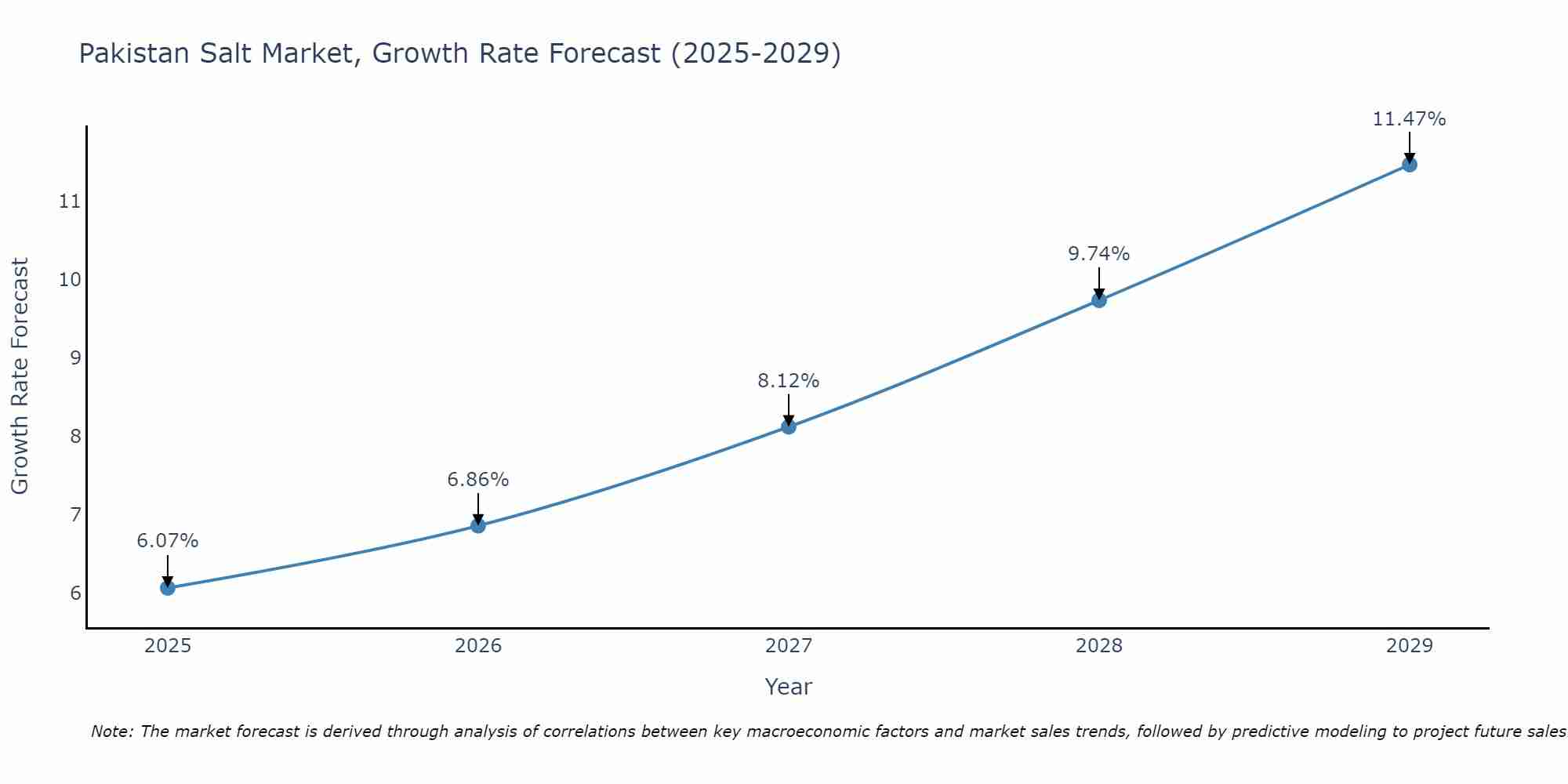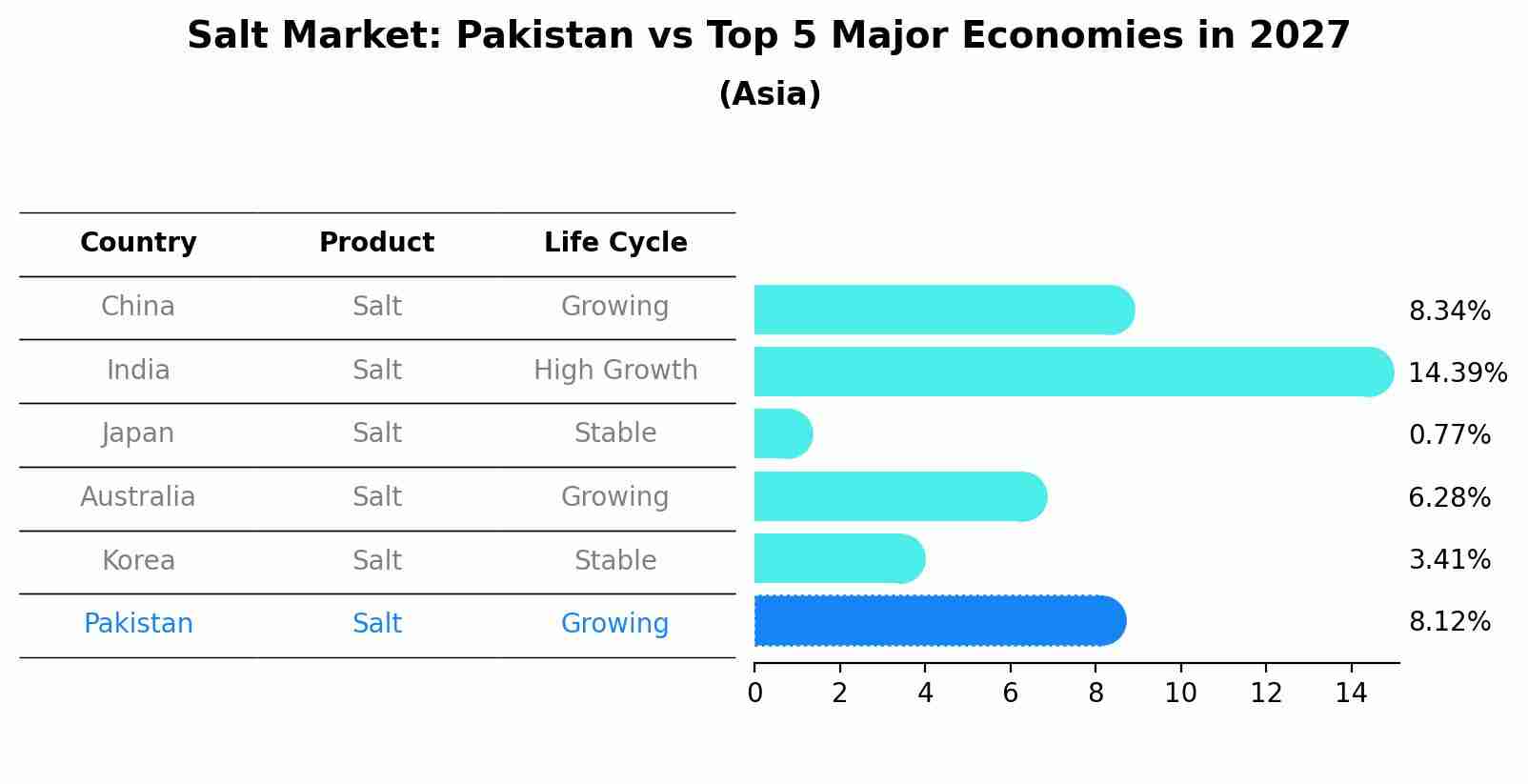Pakistan Salt Market Outlook | Revenue, COVID-19 IMPACT, Companies, Size, Forecast, Analysis, Value, Growth, Trends, Share & Industry
| Product Code: ETC074516 | Publication Date: Jun 2021 | Updated Date: Jun 2025 | Product Type: Report | |
| Publisher: 6Wresearch | Author: Sachin Kumar Rai | No. of Pages: 70 | No. of Figures: 35 | No. of Tables: 5 |
Pakistan Salt Market Size Growth Rate
The Pakistan Salt Market is likely to experience consistent growth rate gains over the period 2025 to 2029. From 6.07% in 2025, the growth rate steadily ascends to 11.47% in 2029.

Salt Market: Pakistan vs Top 5 Major Economies in 2027 (Asia)
Pakistan's Salt market is anticipated to experience a growing growth rate of 8.12% by 2027, reflecting trends observed in the largest economy China, followed by India, Japan, Australia and South Korea.

Pakistan Salt Market Overview
The Pakistan salt market is a significant industry driven by the country`s abundant natural salt reserves, particularly in the Khewra Salt Mines. The market is primarily dominated by the production and export of various types of salt, including Himalayan pink salt, sea salt, and iodized table salt. Pakistan is one of the largest salt producers in the world, with a strong presence in international markets due to the high quality and purity of its salt products. The growing awareness of the health benefits associated with natural salts has further fueled the market`s expansion, with an increasing focus on organic and unprocessed salt varieties. The market is characterized by both large-scale salt manufacturers and numerous small-scale producers, offering a wide range of salt products to cater to diverse consumer preferences.
Pakistan Salt Market Trends
The Pakistan Salt Market is experiencing several key trends. Firstly, there is a growing demand for Himalayan pink salt, known for its perceived health benefits and unique flavor profile. Consumers are increasingly seeking natural and unprocessed salt options, driving the popularity of this premium variety. Secondly, there is a rising awareness of iodized salt`s importance in preventing iodine deficiency disorders, leading to an increased consumption of iodized salt products. Additionally, the trend towards gourmet and specialty salts, such as sea salt and smoked salt, is gaining traction among urban consumers looking to experiment with different flavors in their cooking. Overall, these trends indicate a shift towards more diverse and health-conscious salt choices in the Pakistan market.
Pakistan Salt Market Challenges
In the Pakistan Salt Market, some challenges include inconsistent quality standards, counterfeit products, and price fluctuations due to factors like climate changes and government regulations. The presence of unregulated small-scale producers in the market adds to the issue of quality control, making it challenging for consumers to differentiate between authentic and substandard salt products. Additionally, competition from imported salts, particularly those with lower production costs or higher quality, poses a threat to local salt producers. Addressing these challenges requires improved regulatory oversight, standardization of quality control measures, and marketing efforts to promote the uniqueness and quality of Pakistani salt products in order to maintain a competitive edge in the market.
Pakistan Salt Market Investment Opportunities
The Pakistan Salt Market offers various investment opportunities due to the country`s significant production and export of salt. With Pakistan being the 2nd largest salt producer in the world, investments in salt mining operations, processing facilities, and export ventures can be lucrative. Additionally, there is growing demand for value-added salt products such as Himalayan pink salt and sea salt, presenting opportunities for innovation and differentiation in the market. Investing in technology and infrastructure to improve efficiency and quality control in the salt production process can also be a strategic move. Overall, the Pakistan Salt Market provides a range of investment prospects for those looking to capitalize on the country`s natural resources and expanding global demand for salt products.
Pakistan Salt Market Government Policy
The Pakistan Salt Market is heavily regulated by the government through various policies aimed at ensuring the quality and safety of salt products. The Pakistan Standards and Quality Control Authority (PSQCA) sets standards for salt production, packaging, and labeling to protect consumer health and promote fair trade practices. The government also monitors salt mining activities to prevent environmental degradation and ensure sustainable exploitation of salt reserves. Additionally, the Ministry of National Food Security and Research oversees the overall management of the salt industry, including licensing and inspection of salt processing facilities. These policies not only safeguard the interests of consumers but also support the growth and competitiveness of the Pakistan Salt Market.
Pakistan Salt Market Future Outlook
The future outlook for the Pakistan Salt Market appears positive, driven by factors such as increasing demand for salt in various industries including food processing, chemical, and pharmaceutical sectors. Growing consumer awareness regarding the health benefits of using natural and mineral-rich salts is also expected to boost market growth. Additionally, the rising popularity of gourmet and specialty salts among urban consumers is likely to create new opportunities for market expansion. However, challenges such as fluctuating raw material prices and environmental concerns related to salt mining practices may pose obstacles to market growth. Overall, with strategic marketing efforts, product innovation, and sustainable practices, the Pakistan Salt Market is poised for steady growth in the coming years.
Key Highlights of the Report:
- Pakistan Salt Market Outlook
- Market Size of Pakistan Salt Market, 2021
- Forecast of Pakistan Salt Market, 2027
- Historical Data and Forecast of Pakistan Salt Revenues & Volume for the Period 2018 - 2027
- Pakistan Salt Market Trend Evolution
- Pakistan Salt Market Drivers and Challenges
- Pakistan Salt Price Trends
- Pakistan Salt Porter's Five Forces
- Pakistan Salt Industry Life Cycle
- Historical Data and Forecast of Pakistan Salt Market Revenues & Volume By Type for the Period 2018 - 2027
- Historical Data and Forecast of Pakistan Salt Market Revenues & Volume By Rock Salt for the Period 2018 - 2027
- Historical Data and Forecast of Pakistan Salt Market Revenues & Volume By Brine for the Period 2018 - 2027
- Historical Data and Forecast of Pakistan Salt Market Revenues & Volume By Solar Salt for the Period 2018 - 2027
- Historical Data and Forecast of Pakistan Salt Market Revenues & Volume By Others for the Period 2018 - 2027
- Historical Data and Forecast of Pakistan Salt Market Revenues & Volume By Applications for the Period 2018 - 2027
- Historical Data and Forecast of Pakistan Salt Market Revenues & Volume By Chemical Processing for the Period 2018 - 2027
- Historical Data and Forecast of Pakistan Salt Market Revenues & Volume By Road De-icing for the Period 2018 - 2027
- Historical Data and Forecast of Pakistan Salt Market Revenues & Volume By Food Processing for the Period 2018 - 2027
- Historical Data and Forecast of Pakistan Salt Market Revenues & Volume By Others for the Period 2018 - 2027
- Pakistan Salt Import Export Trade Statistics
- Market Opportunity Assessment By Type
- Market Opportunity Assessment By Applications
- Pakistan Salt Top Companies Market Share
- Pakistan Salt Competitive Benchmarking By Technical and Operational Parameters
- Pakistan Salt Company Profiles
- Pakistan Salt Key Strategic Recommendations
Frequently Asked Questions About the Market Study (FAQs):
1 Executive Summary |
2 Introduction |
2.1 Key Highlights of the Report |
2.2 Report Description |
2.3 Market Scope & Segmentation |
2.4 Research Methodology |
2.5 Assumptions |
3 Pakistan Salt Market Overview |
3.1 Pakistan Country Macro Economic Indicators |
3.2 Pakistan Salt Market Revenues & Volume, 2021 & 2027F |
3.3 Pakistan Salt Market - Industry Life Cycle |
3.4 Pakistan Salt Market - Porter's Five Forces |
3.5 Pakistan Salt Market Revenues & Volume Share, By Type, 2021 & 2027F |
3.6 Pakistan Salt Market Revenues & Volume Share, By Applications, 2021 & 2027F |
4 Pakistan Salt Market Dynamics |
4.1 Impact Analysis |
4.2 Market Drivers |
4.3 Market Restraints |
5 Pakistan Salt Market Trends |
6 Pakistan Salt Market, By Types |
6.1 Pakistan Salt Market, By Type |
6.1.1 Overview and Analysis |
6.1.2 Pakistan Salt Market Revenues & Volume, By Type, 2018 - 2027F |
6.1.3 Pakistan Salt Market Revenues & Volume, By Rock Salt, 2018 - 2027F |
6.1.4 Pakistan Salt Market Revenues & Volume, By Brine , 2018 - 2027F |
6.1.5 Pakistan Salt Market Revenues & Volume, By Solar Salt, 2018 - 2027F |
6.1.6 Pakistan Salt Market Revenues & Volume, By Others, 2018 - 2027F |
6.2 Pakistan Salt Market, By Applications |
6.2.1 Overview and Analysis |
6.2.2 Pakistan Salt Market Revenues & Volume, By Chemical Processing, 2018 - 2027F |
6.2.3 Pakistan Salt Market Revenues & Volume, By Road De-icing, 2018 - 2027F |
6.2.4 Pakistan Salt Market Revenues & Volume, By Food Processing, 2018 - 2027F |
6.2.5 Pakistan Salt Market Revenues & Volume, By Others, 2018 - 2027F |
7 Pakistan Salt Market Import-Export Trade Statistics |
7.1 Pakistan Salt Market Export to Major Countries |
7.2 Pakistan Salt Market Imports from Major Countries |
8 Pakistan Salt Market Key Performance Indicators |
9 Pakistan Salt Market - Opportunity Assessment |
9.1 Pakistan Salt Market Opportunity Assessment, By Type, 2021 & 2027F |
9.2 Pakistan Salt Market Opportunity Assessment, By Applications, 2021 & 2027F |
10 Pakistan Salt Market - Competitive Landscape |
10.1 Pakistan Salt Market Revenue Share, By Companies, 2021 |
10.2 Pakistan Salt Market Competitive Benchmarking, By Operating and Technical Parameters |
11 Company Profiles |
12 Recommendations |
13 Disclaimer |
- Single User License$ 1,995
- Department License$ 2,400
- Site License$ 3,120
- Global License$ 3,795
Search
Thought Leadership and Analyst Meet
Our Clients
Related Reports
- Afghanistan Rocking Chairs And Adirondack Chairs Market (2026-2032) | Size & Revenue, Competitive Landscape, Share, Segmentation, Industry, Value, Outlook, Analysis, Trends, Growth, Forecast, Companies
- Afghanistan Apparel Market (2026-2032) | Growth, Outlook, Industry, Segmentation, Forecast, Size, Companies, Trends, Value, Share, Analysis & Revenue
- Canada Oil and Gas Market (2026-2032) | Share, Segmentation, Value, Industry, Trends, Forecast, Analysis, Size & Revenue, Growth, Competitive Landscape, Outlook, Companies
- Germany Breakfast Food Market (2026-2032) | Industry, Share, Growth, Size, Companies, Value, Analysis, Revenue, Trends, Forecast & Outlook
- Australia Briquette Market (2025-2031) | Growth, Size, Revenue, Forecast, Analysis, Trends, Value, Share, Industry & Companies
- Vietnam System Integrator Market (2025-2031) | Size, Companies, Analysis, Industry, Value, Forecast, Growth, Trends, Revenue & Share
- ASEAN and Thailand Brain Health Supplements Market (2025-2031) | Strategy, Consumer Insights, Analysis, Investment Trends, Opportunities, Growth, Size, Share, Industry, Revenue, Segments, Value, Segmentation, Supply, Forecast, Restraints, Outlook, Competition, Drivers, Trends, Demand, Pricing Analysis, Competitive, Strategic Insights, Companies, Challenges
- ASEAN Bearings Market (2025-2031) | Strategy, Consumer Insights, Analysis, Investment Trends, Opportunities, Growth, Size, Share, Industry, Revenue, Segments, Value, Segmentation, Supply, Forecast, Restraints, Outlook, Competition, Drivers, Trends, Demand, Pricing Analysis, Competitive, Strategic Insights, Companies, Challenges
- Europe Flooring Market (2025-2031) | Outlook, Share, Industry, Trends, Forecast, Companies, Revenue, Size, Analysis, Growth & Value
- Saudi Arabia Manlift Market (2025-2031) | Outlook, Size, Growth, Trends, Companies, Industry, Revenue, Value, Share, Forecast & Analysis
Industry Events and Analyst Meet
Whitepaper
- Middle East & Africa Commercial Security Market Click here to view more.
- Middle East & Africa Fire Safety Systems & Equipment Market Click here to view more.
- GCC Drone Market Click here to view more.
- Middle East Lighting Fixture Market Click here to view more.
- GCC Physical & Perimeter Security Market Click here to view more.
6WResearch In News
- Doha a strategic location for EV manufacturing hub: IPA Qatar
- Demand for luxury TVs surging in the GCC, says Samsung
- Empowering Growth: The Thriving Journey of Bangladesh’s Cable Industry
- Demand for luxury TVs surging in the GCC, says Samsung
- Video call with a traditional healer? Once unthinkable, it’s now common in South Africa
- Intelligent Buildings To Smooth GCC’s Path To Net Zero


















